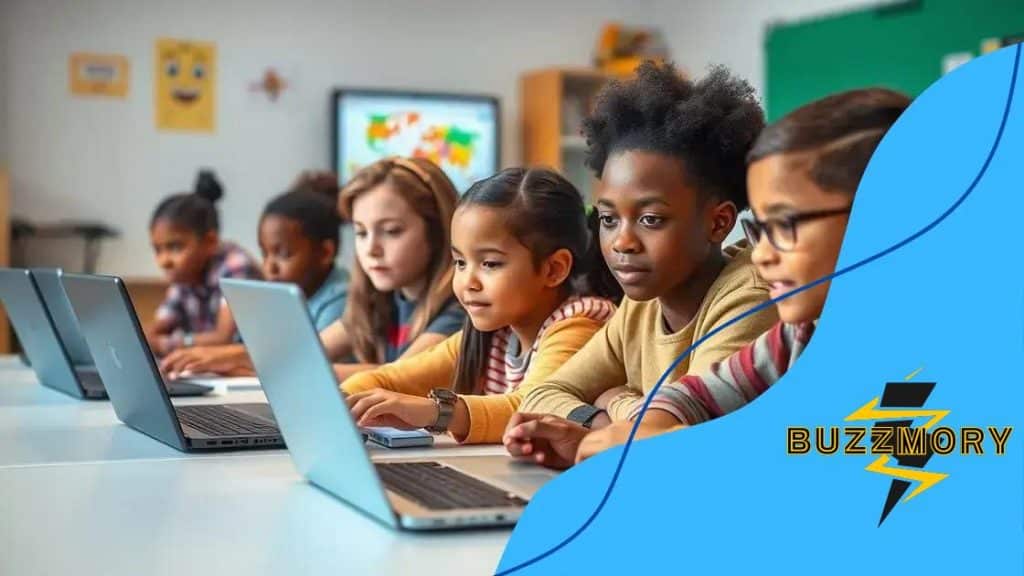Trends in virtual classrooms for K-12 education

Trends in virtual classrooms for K-12 education include personalized learning experiences, hybrid models combining online and in-person instruction, a focus on social and emotional learning, and the use of innovative tools to enhance student engagement.
Trends in virtual classrooms for K-12 education are evolving rapidly, transforming the learning experience. Have you noticed how much technology has changed your child’s classroom? Let’s dive into the movements reshaping education.
The rise of blended learning in K-12
The rise of blended learning in K-12 education is transforming the way students experience learning. This approach combines traditional classroom methods with online learning, creating a flexible educational environment.
Many schools are adopting this model because it offers numerous benefits. Students can learn at their own pace while still receiving necessary support from teachers.
Benefits of Blended Learning
Blended learning facilitates personalized instruction, allowing teachers to tailor lessons to individual student needs. Here are some key benefits:
- Increased Flexibility: Students can choose when and where to learn.
- Personalized Learning: Lessons can be adapted to different learning styles.
- Enhanced Engagement: Interactive online content keeps students interested.
- Improved Access: Students can access resources anytime, anywhere.
As technology advances, the possibilities within blended learning continue to expand. This model promotes self-directed learning, encouraging students to take responsibility for their education.
Implementing Blended Learning
Schools implementing blended learning must ensure that teachers receive adequate training. It’s crucial for teachers to understand both online tools and in-class strategies.
By merging face-to-face interaction with digital resources, students can benefit from the best of both worlds. The supportive presence of a teacher combined with the independence of online learning equips students for success.
Moreover, as blended learning becomes more common, educators are continually discovering new methods to enhance student learning experiences. Evaluating how students respond to these methods can inform future practices.
Innovative tools shaping virtual classrooms
Innovative tools shaping virtual classrooms are transforming the educational landscape. These tools offer exciting opportunities for educators and students alike, making learning more engaging and effective.
Technology plays a critical role in enhancing the virtual learning experience. From interactive software to collaboration platforms, teachers are equipped with resources to support their students in new ways.
Key Tools in Virtual Classrooms
Some popular tools that have changed the way classes are conducted include:
- Video Conferencing: Platforms like Zoom and Google Meet allow real-time interaction.
- Learning Management Systems: Tools such as Google Classroom and Moodle organize course materials and assignments.
- Collaborative Tools: Software like Padlet and Trello encourages teamwork and idea sharing.
- Interactive Quizzes: Tools like Kahoot! and Quizizz make learning fun and competitive.
These tools not only facilitate teaching but also help students take charge of their learning. With features such as instant feedback and accessibility, students can engage with content more effectively.
Moreover, the integration of gamification into virtual classrooms has made learning more stimulating. Game-based elements in education encourage participation and motivation among students.
The Impact on Student Engagement
As educators incorporate innovative tools, student engagement rises significantly. Engaged learners are more likely to retain information and participate actively in discussions.
Teachers can track progress through analytics provided by many digital tools. This feedback allows for timely adjustments in teaching strategies. By understanding student performance, educators can better support each learner’s journey.
Engagement strategies for online learners

Engagement strategies for online learners are essential in creating a productive virtual classroom. Without face-to-face interaction, it can be challenging to keep students involved and motivated.
Effective strategies can make a big difference in how students participate and learn in a virtual setting. By using diverse techniques, teachers can foster an engaging learning environment.
Interactive Learning Methods
Incorporating interactive elements into online classes encourages students to stay focused. Here are some strategies:
- Polls and Quizzes: Use tools like Poll Everywhere or Kahoot! to make learning fun.
- Discussion Boards: Create forums for students to share thoughts and ask questions.
- Breakout Rooms: Allow students to work in small groups during live sessions.
- Gamified Lessons: Introduce game-like elements to increase motivation.
These methods help students participate actively rather than passively absorb information. Using varied approaches captures their attention and improves understanding.
Additionally, creating a sense of community is vital. Encouraging peer interaction fosters collaboration and builds relationships among students. Group projects can bridge gaps between individuals, making the virtual setting feel more connected.
Feedback and Communication
Regular feedback plays a crucial role in online learning. Students benefit from knowing how they are doing and what areas need improvement. Teachers should provide constructive feedback on assignments promptly.
Open communication channels also enhance engagement. Utilizing emails, chat features, or even social media groups keeps students informed and encourages them to reach out when they need help.
Teachers should be approachable and available, creating a supportive atmosphere where students feel comfortable sharing their thoughts and concerns. This connection can significantly enhance student participation and motivation.
Challenges of virtual education for teachers
The challenges of virtual education for teachers are becoming more evident as online learning becomes more common. Many educators face difficulties that can hinder their ability to teach effectively in a virtual environment.
One major challenge is the lack of face-to-face interaction. Teachers often find it difficult to gauge student understanding without physical presence. This absence can lead to miscommunication and a feeling of disconnect between teachers and students.
Technological Barriers
Teachers also encounter various technological issues. Some of these include:
- Access to Devices: Not all students have reliable devices, which can create disparities in learning.
- Internet Connectivity: Inconsistent or lack of internet access hampers participation.
- Software Familiarity: Teachers may struggle to use new platforms effectively.
- Technical Support: Limited access to IT support when problems arise can add stress.
These barriers can prevent teachers from engaging their students fully. As virtual classrooms continue to evolve, addressing these issues becomes increasingly important.
Maintaining Student Motivation
Another significant challenge teachers face is maintaining student motivation. In a virtual classroom, distractions can be plentiful. Students may divert their attention to other activities, making it hard for teachers to keep them engaged.
To combat this, teachers need to develop strategies that enhance interest and participation. Using interactive activities and varied instructional methods can help keep students focused. However, this requires extra effort and creativity from educators.
Furthermore, the emotional toll on teachers should not be overlooked. The pressure to adapt quickly to new teaching modalities can lead to burnout. Support from administration and colleagues is essential to help teachers navigate these adjustments successfully.
Future predictions for K-12 online learning
Future predictions for K-12 online learning suggest significant changes in how education will be delivered in the coming years. As technology evolves, so do the methods and approaches used in virtual classrooms.
One major prediction is the continued growth of personalized learning. With advances in artificial intelligence, educational platforms will tailor learning experiences to fit individual students’ needs. This means students can progress at their own pace, accessing resources based on their unique abilities.
The Rise of Hybrid Models
Another anticipated trend is the rise of hybrid learning models. These combine in-person and online instruction, providing flexibility for both students and teachers. Benefits of this approach include:
- Better Resource Allocation: Schools can use physical spaces more efficiently.
- Increased Engagement: Students often find hybrid environments more stimulating.
- Adaptability: Teachers can quickly shift between formats as needed.
This adaptability will enable schools to respond better to changes in public health, technology, and educational needs.
Emphasis on Social and Emotional Learning
Experts predict a stronger focus on social and emotional learning (SEL) within online environments. This approach addresses students’ mental health needs and fosters emotional intelligence.
With an increase in stress and anxiety among students, integrating SEL into the curriculum will become essential. Virtual classrooms will include activities and discussions that promote emotional well-being and resilience.
Additionally, collaboration tools will play a critical role in enhancing student interaction. As new platforms emerge, they will facilitate teamwork among students, even in virtual settings. This increased connectivity helps build essential skills needed for future careers.
FAQ – Frequently Asked Questions about K-12 Online Learning
What is personalized learning in K-12 online education?
Personalized learning allows students to learn at their own pace and access resources tailored to their individual needs.
What are hybrid learning models?
Hybrid learning models combine online instruction with in-person teaching, providing flexibility and interactive learning experiences.
Why is social and emotional learning important?
Social and emotional learning helps students manage their emotions, build relationships, and improve their overall well-being.
How do collaboration tools enhance online learning?
Collaboration tools foster interaction among students, promoting teamwork and communication in a virtual environment.





